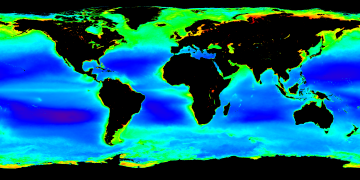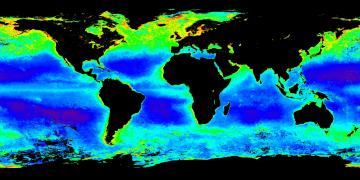Source DataThe CZCS data was obtained in a raw format associated with the original 9-track tape storage (CRTT format). Each file contained approximately 2 minutes of data. There were many files with duplicate or overlapping data segments, and many files with corrupted data. A more detailed discussion of the CZCS data collection is
here.
Level-1AThe CRTT files were first converted to Hierarchical Data Format (HDF). The
HDF Level-1A format incorporates the raw counts from the CRTT files, as well as all relevant telemetry and quality information. Extensive quality control was performed to filter-out the corrupted data. The small files were then
merged to form one file per orbit, with best quality selected where duplicate scans were found. In addition, the OBPG incorporated the navigation biases described in
Gregg et al. 2002 and orbit vectors obtained from archives of the SMMR instrument on NIMBUS-7 to improve geolocation and
knowledge of the view path geometries, respectively.
Level-2The OBPG incorporated CZCS processing capabilities into the Multi-Sensor Level-1 to Level-2 code (MSL12). The
Level-2 format is very similar to that of SeaWiFS or MODIS ocean products, which are also produced with MSL12. The processing algorithm differs only to the extent required to account for the limitations of the CZCS instrument and to account for known CZCS instrument problems (e.g.,
electronic hysteresis). Lacking the NIR bands, the aerosol correction was performed using the longest functional wavelength (670 nm). An iteration scheme similar to
Stumpf et al. 2003 was developed to determine the water-leaving radiance contribution at 670 nm and thereby the aerosol contribution at that wavelength, and a fixed maritime aerosol model (M99) was employed to extrapolate the aerosol signal from 670 nm to the other visible wavelengths. A more detailed discussion of the
atmospheric correction developed for CZCS is here.The CZCS instrument also lacked onboard calibration capabilities such as the solar diffuser and lunar observations incorporated into modern sensors to track temporal degradation in instrument response. The OBPG employed the model of
Evans and Gordon (1994) for the temporal calibration of CZCS for this reprocessing, after
verifying the calibration trends using modern techniques. A
final vicarious calibration was then performed using climatological chlorophyll trends from the Bermuda Atlantic Time Series (BATS) and an updated version of the bio-optical model developed by Morel & Maritorena (2002). A list of the standard Level-2 products is presented in Table 1. The chlorophyll algorithm is the OC3 form from O'Reilly et al. (2000), but tuned for CZCS bands at 443, 520, and 550 nm.
Table 1: Standard Level-2 Product Suite for CZCS | name | description |
| chlor_a | chlorophyll-a concentration (OC3) |
| nLw_443 | normalized water-leaving radiance at 443 nm |
| nLw_520 | normalized water-leaving radiance at 520 nm |
| nLw_550 | normalized water-leaving radiance at 550 nm |
| nLw_670 | normalized water-leaving radiance at 670 nm (reflectance model) |
| tau_670 | aerosol optical thickness at 670 nm |
| epsilon | aerosol epsilon at 550 relative to 670 (M90 aerosol model) |
| angstrom_520 | aerosol Angstrom coefficient at 520 relative to 670 nm (M90 aerosol model) |
Level-3The Level-2 products were binned to daily, 8-day, and monthly Level-3 products using the same software and formats currently employed for MODIS, SeaWiFS, and OCTS processing within the OBPG. The
Level-3 binned data was generated at a spatial resolution of approximately 4.6 x 4.6-km, and
mapped to equirectangular projections at both 0.044-deg and 0.088-deg resolutions (like MODIS).
Comparison with In Situ MeasurementsRadiance and chlorophyll retrievals are in
good agreement with in situ measurements from the CZCS era, but the data set is extremely limited.
Comparison with SeaWiFSMission-averaged, global chlorophyll retrievals show remarkable similarity to current SeaWiFS mission-averaged products, despite the
high variability in CZCS sampling.
{C}{C}
| SeaWiFS | CZCS |
 |  |
A detailed
analysis of temporal trends relative to SeaWiFS was also performed. Results show some low bias in the CZCS retrieved water-leaving radiances, especially at 443 nm in mid-mission, which may be due to uncorrected calibration biases, lack of polarization corrections, or influence of absorbing aerosol associated with the
El Chichon erruption.Bi-modal nLw HistogramsEvans and Gordon (1994) described a second maximum appearing in the histograms of global normalized water-leaving radiance in bands 2 and 3 (520 and 550nm,respectively) begining in the fall of 1981. They suggest that this is an instrumental artifact, as it was not seen in the first 2 and a half years of the mission. This effect can be clearly seen in the
seasonal Level 3 mapped nLw(520) for the Autumn of 1981. The distinct hemispheric dicotomy supports the supposition of Evans and Gordon. The root cause for this problem is under investigation. The OBPG has made an extensive effort to reprocess and evaluate CZCS ocean color products in a manner that is consistent with the approach used for modern ocean color sensors. However, it must be recognized that the CZCS instrument was a proof-of-concept mission, and as such the limitations in instrument design, prelaunch characterization, and on-orbit calibration capabilities neccessarily reduce our confidence in the results. For example, the lack of NIR bands requires that we make some additional assumptions to assess aerosol contributions, and while we know that CZCS has significant polarization sensitivity, we lack sufficient characterization data to correct for that effect. Similarly, CZCS was not characterized for changes in instrument response with temperature, but we know that the instrument was sometimes temperature cycled operationally. Furthermore, vicarious techniques must be used to assess temporal degradation in instrument response, which requires some assumptions about atmospheric and ocean contributions and variability. While
the global sampling for CZCS was very sparce and uneven temporally and spatially, there were some coastal regions, e.g. the U.S. East and West coasts and Europe, that have reasonably good coverage over the mission and can be used for studies of seasonal and interannual variability. However, after August 1981, the radiometry, particularly in the Southern Hemisphere, appears anomalous. Finally, there were several major
volcanic erruptions during the CZCS mission, including
El Chichon in 1982 that contributed a massive aerosol load into the upper atmosphere that required several years to disipate. We would have difficulty correcting modern sensors for such an event. Considering these limitations and concerns, we feel the CZCS data (as provided) would be most useful for qualitative analyses, with quantitative uses limited to relative change on small spatial and temporal scales.
Evans and Gordon (1994).
"Coastal zone color scanner 'system calibration': A retorspective examination", JGR, vol 99 no. C4, pp 7293 -- 7307.
Gregg, W.W., M.E. Conkright, J.E. O'Reilly, F.S. Patt, M.H. Wang, J.A. Yoder, and N.W. Casey (2002).
"NOAA-NASA Coastal Zone Color Scanner Reanalysis Effort ," Appl. Opt. 41, 1615-1628.
O'Reilly, J.E., and 24 Coauthors (2000).
SeaWiFS Postlaunch Calibration and Validation Analyses, Part 3. NASA Tech. Memo. 2000-206892, Vol. 11, S.B. Hooker and E.R. Firestone, Eds., NASA Goddard Space Flight Center, 49 pp.
ERROR @ Ocean Biology Distributed Active Archive Center (OB.DAAC)
.:. ERROR .:.
Ocean Biology Distributed Active Archive Center (OB.DAAC)

